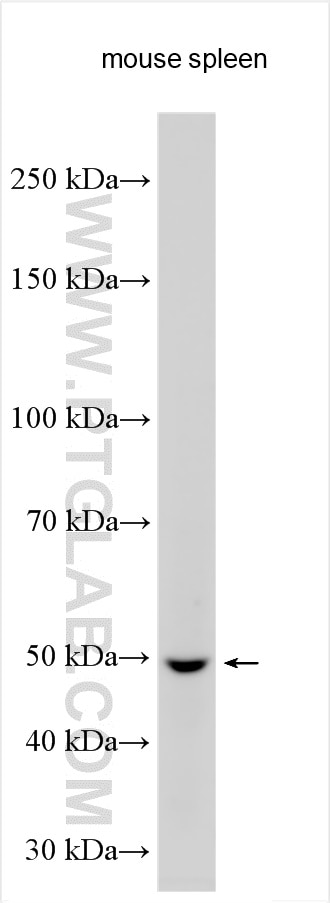PNPLA1 Polyklonaler Antikörper
PNPLA1 Polyklonal Antikörper für WB, ELISA
Wirt / Isotyp
Kaninchen / IgG
Getestete Reaktivität
human, Maus
Anwendung
WB, ELISA
Konjugation
Unkonjugiert
Kat-Nr. : 30905-1-AP
Synonyme
Geprüfte Anwendungen
| Erfolgreiche Detektion in WB | Mausmilzgewebe |
Empfohlene Verdünnung
| Anwendung | Verdünnung |
|---|---|
| Western Blot (WB) | WB : 1:500-1:2000 |
| It is recommended that this reagent should be titrated in each testing system to obtain optimal results. | |
| Sample-dependent, check data in validation data gallery | |
Produktinformation
30905-1-AP bindet in WB, ELISA PNPLA1 und zeigt Reaktivität mit human, Maus
| Getestete Reaktivität | human, Maus |
| Wirt / Isotyp | Kaninchen / IgG |
| Klonalität | Polyklonal |
| Typ | Antikörper |
| Immunogen | PNPLA1 fusion protein Ag34139 |
| Vollständiger Name | patatin-like phospholipase domain containing 1 |
| Berechnetes Molekulargewicht | 532 aa, 58 kDa |
| Beobachtetes Molekulargewicht | 48kDa;58kDa |
| GenBank-Zugangsnummer | BC103907 |
| Gene symbol | PNPLA1 |
| Gene ID (NCBI) | 285848 |
| Konjugation | Unkonjugiert |
| Form | Liquid |
| Reinigungsmethode | Antigen-Affinitätsreinigung |
| Lagerungspuffer | PBS with 0.02% sodium azide and 50% glycerol |
| Lagerungsbedingungen | Bei -20°C lagern. Nach dem Versand ein Jahr lang stabil Aliquotieren ist bei -20oC Lagerung nicht notwendig. 20ul Größen enthalten 0,1% BSA. |
Hintergrundinformationen
PNPLA1 is a member of the patatin-like phospholipase (PNPLA) family. PNPLAs are highly conserved enzymes of prokaryotic and eukaryotic organisms that play an important role in lipid homeostasis. PNPLA1 has been identified as an essential transacylase for acylceramide biosynthesis to maintain the epidermal permeability barrier (PMID: 30290227). It is mainly expressed in the skin and has 3 isoforms with MW of 58, 48 and 49 kDa.
Protokolle
| PRODUKTSPEZIFISCHE PROTOKOLLE | |
|---|---|
| WB protocol for PNPLA1 antibody 30905-1-AP | Protokoll herunterladen |
| STANDARD-PROTOKOLLE | |
|---|---|
| Klicken Sie hier, um unsere Standardprotokolle anzuzeigen |


